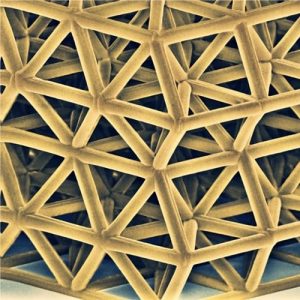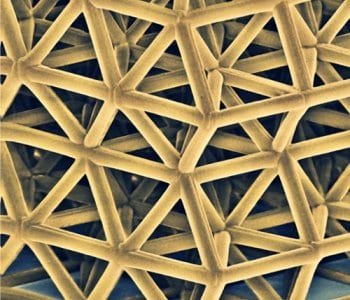 Lattice materials with designed periodic spatial architecture are mechanically superior to stochastic cellular materials such as foams, and also hold the potential to offer property combinations, such as high strength and low density, which may not be accessible by monolithic materials. It has been shown that the size of the features which such lattices are comprised of plays a crucial role with respect to the achievable strength. Miniaturizing their features to the micrometer and nanometer scale enables to exploit beneficial mechanical size effects. The high strength of ceramic and ceramic composite microlattices has been attributed to the fact that the flaw size, which limits the strength of brittle materials, in the nanometer range scales with the dimensions of an object.
Lattice materials with designed periodic spatial architecture are mechanically superior to stochastic cellular materials such as foams, and also hold the potential to offer property combinations, such as high strength and low density, which may not be accessible by monolithic materials. It has been shown that the size of the features which such lattices are comprised of plays a crucial role with respect to the achievable strength. Miniaturizing their features to the micrometer and nanometer scale enables to exploit beneficial mechanical size effects. The high strength of ceramic and ceramic composite microlattices has been attributed to the fact that the flaw size, which limits the strength of brittle materials, in the nanometer range scales with the dimensions of an object.
In this paper, the strength of micro-architected alumina-polymer composite lattice materials having different strut and coating dimensions in both compression and tension have been investigated. Uniaxial compression and tension experiments were performed on several different lattice topologies. Jens Bauer et al. from KIT show that the strength of polymer-alumina core-shell composite microlattices doubles when their size is scaled down by 50%. Isotropic strength under tension and compression was achieved when observed thickness-dependent notch effects in the alumina shells were accounted for.

















